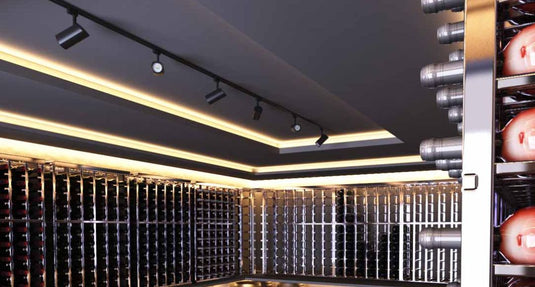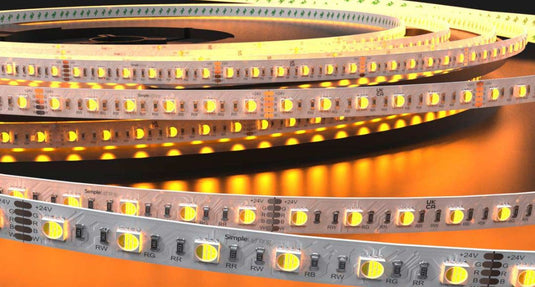Bending the Rules: Installing LED Strips on Challenging Surfaces in Your Home
Everyone who loves DIY projects loves LED strip lights because of their versatility and flexibility, both literally and figuratively. Of course, there’s also the cost-effective feature of using LED: it’s energy-efficient and long-lasting. But the versatility is what we DIYers are here for the most.
With traditional tube lights, fluorescent tubes, or linear light bulbs, navigating corners and uneven surfaces poses a significant challenge. Now with LED strip lights, we’re able to address those challenges. But, even with the flexibility offered by LED light strip installation, corners and uneven surfaces can still be tricky if you don’t know what you’re doing.
Say you've just started with DIY or are a veteran looking for more efficient ways to mount LED strip lights. In that case, this article will provide you with practical techniques and tips for successful installation.
Navigating Corners: Simple Solutions for Your LED Strip Light Project
Using LED Strip Light Connectors (Solderless Corner Connectors)
People who know how to solder rock! But if you’re inexperienced or just terrible at soldering, then these beginner-friendly connectors are perfect for you. They eliminate the need for soldering while creating a secure connection around corners. They come in different types: L-shaped and hinged. It’s a quick and easy way to connect each strip without bending them.
They’re simple to use. Simply cut the strips to your desired length, clamp the ends of the strips you want to connect to the connector, and you’re done. One end can be connected to a power wire, which is especially useful when you need to go over obstacles, such as cabinet beams.
Folding or Bending the LED Strip
Do this with precautions! Yes, LED strip lights are generally flexible, which means you can bend them, but with extreme caution. Improper bending techniques can cause poor light distribution or even damage the components of the strip light. If you need to bend your LED strip lights, we suggest doing so along the cutting marks or, better yet, bending them in a wide arc to avoid damaging the circuitry.
Caution: Avoid sharp creases, which can break circuits.
Making it Stick: Applying LED Strips to Uneven Walls and Surfaces
Using Stronger Adhesive Backing
Most LED strip lights come with a pre-applied adhesive backing. We’ll tell you this now: they’re not meant for long-term or heavy-duty applications. We recommend using higher-quality, strong double-sided adhesive tape designed for various surfaces.
Here’s what to do for maximum adhesion:
-
Clean and dry out the surface
-
Make sure the area is smooth
-
Measure and cut the adhesive tape
-
Apply tape firmly, and ensure there is proper contact
-
Guarantee that there are no air bubbles (avoid stretching the tape)
Employing Mounting Clips and Screws
For surfaces that are not smooth (textured walls, brickwork, or areas where strong adhesion is difficult), mounting clips and screws are the most reliable options. These small clips can either have only one screw or two screws on both sides, with a plastic bracket that “clips” over your LED strips to hold it in place.
Position your LED strip lights in between the clip, and screw the clips to secure it, making sure to follow the contour of the surface for a clean look.
Using Flexible LED Strip Channels/Profiles
Flexible LED strip channels can bend, curve, and twist to conform to various surfaces. This provides your strip lights with a stable and secure mounting base to adhere to. Using these channels or profiles can result in a clean and aesthetically pleasing installation.
These profiles come with brackets you can screw into the surface. Next, secure the profiles in the bracket. Lastly, carefully insert the LED strip lights into the profile.
Segmenting the LED Strip
The problem with installing a single strand of LED strip light on an uneven surface or in corners is that it can be challenging to manage during the mounting process. You know what’s easier to manage? Shorter LED strip lights. Yes, you can cut your long LED strip lights into smaller segments for better navigation around uneven areas. You’ll be using a lot more solderless connectors, but it will be easier to install than working with a whole strip of LED lights.
Your UK DIY Guide: Corner and Uneven Surface Installation in Action
Alright, now you know everything you need to consider before installing your LED strip lights around corners and uneven surfaces. It’s time to take action:

Installing Around a 90-Degree Corner using Connectors
As we mentioned above, using solderless connectors is a fast and easy way to get around corners. Here’s how you do it:
-
Make sure your LED strip light is unplugged.
-
Carefully cut your LED strip. Only trim on the cutting mark. There’s usually an image of a pair of scissors, so it’s hard to miss!
-
Get your connector and align one end of the LED strip, specifically the end where you made the cut.
-
Press down on the connector’s “cap” to snap the LED in place.
-
Repeat Step 4 on the other end of the connector.
Connectors come in different styles: a white polycarbonate connector (stiff, 90 degrees) and an L-wire connector (flexible, able to bend to a wider angle than 90 degrees).
Gently Bending LED Strips Around a Corner
While solderless connectors can give you a clean and professional installation, another way to navigate those tight corners is by bending your LED strip light. The bendability of the strip light will vary depending on the model of the strip light, so always take that into consideration.
Although it might be scary at first, since there’s a risk of messing up the LED components, this is relatively easy to do, and there are a few ways to do it.
90-degree pinch
-
Mark where you need to make the bend.
-
Lay the LED strip flat on the surface.
-
Pinch the strip where you marked it.
-
Twist to create a 90-degree angle.
-
Use super glue, tape, or a mounting clip to hold the pinch in place.
“Professional” fold
-
Mark where you need to make the bend.
-
Lay the LED strip flat on the surface.
-
Fold the strip at a 45-degree angle away from where you need the strip to go. (If you need it to go forward, fold back. If you need it to go backwards, fold forward.)
-
Fold the strip back in the opposite direction to create the 90-degree fold.
-
Press the fold gently to flatten it.
-
Use super glue, tape, or a mounting clip to hold the fold in place.
Applying LED Strips to a Slightly Textured Wall Using Strong Adhesive
If you’re mounting your LED strips using adhesive, don’t use the one that’s pre-applied by itself. Get a stronger adhesive for a more durable and long-lasting application.
-
Clean the surface and ensure it’s dry before installing your LED strip lights.
-
Unroll your heavy-duty, double-sided adhesive tape while being careful not to stretch it, to avoid air bubbles.
-
Cut off the section where you touched the adhesive part to avoid compromising the adhesion.
-
Apply immediate pressure to the tape or use a roller to help it wrap around and stick better to the uneven surface of the textured wall.
-
Remove the tape’s liner in one go. This is to avoid having “stop marks” on the tape.
-
Carefully position and stick your LED strips to the adhesive immediately to avoid dirt from getting on them.
-
Press gently along the strip to secure adhesion.
-
Don’t move the strip once it’s attached to the adhesive, or else you’ll compromise it.
-
Some adhesives need time to cure and achieve their full bond strength.
Installing LED Strips on a Very Uneven Surface Using Mounting Clips
There are surfaces where adhesive tapes just won’t be enough to install your LED strip lights without them falling off. That’s where the mounting clips come in.
-
Plan out how you’ll navigate the LED strip lights on the uneven surface. Putting markers can help.
-
Carefully cut the LED strips if you plan to use smaller segments for easier navigation.
-
Partially screw the first mounting clip, starting from one end.
-
Place the LED strip between the mounting clip and the surface.
-
Finish screwing the mounting clip in place until the strip is secured in place.
-
Continue doing steps 3 to 5 until you reach the end of the installation.
Note: If you’re using smaller segments, make sure to attach the segments to the connectors properly. Use solderless connectors for easier and faster connections.
Your DIY Toolkit: What You'll Need for Corners and Uneven Surfaces
Alright, now you’re practically an expert in LED strip light installation. And experts have expert tools. Don’t worry, we've got you. You can check out our complete guide on Essential Tools for Installing LED Strip Lights. Here, we’ll list and explain the essential tools needed for a successful and safe DIY LED strip light installation:
-
Measuring tape
-
Pencil/marker
-
Sharp scissors/utility knife
-
Solderless corner connectors
-
Strong double-sided adhesive tape
-
Mounting clips and small screws
-
Screwdriver
-
Flexible LED strip channels (if applicable)
Pro Tips for a Seamless Look on Corners and Uneven Surfaces in Your Home
Sloppy workmanship can result in a messy lighting setup when it comes to your LED strips. And you don’t want that, especially if you installed the lights for aesthetic reasons. Here are some tips on how to keep your LED strip installation clean:
-
Plan your layout carefully, taking into account the bends and contours.
-
Use the correct type of connector or bending technique for the corner angle.
-
Ensure the adhesive or mounting clips are appropriate for the surface material.
-
Conceal wires neatly using cable clips or channels.
-
Take your time and work methodically for the best results.
DIY Safety First: Important Considerations
Safety always comes first: for you and everyone else. Keep this in mind when installing your LED strip lights:
-
Always disconnect power before cutting or connecting LED strips.
-
Avoid overloading power supplies.
-
Be careful when using sharp tools.
-
If unsure about any electrical connections, consult a qualified electrician.
Ready to Tackle Those Tricky Spots? Shop Our LED Strip Light Accessories!
LED Supplier offers a wide range of high-quality accessories to make your LED strip light installations a breeze. Browse through our selection of LED tapes, profiles, controllers, and complete kits perfect for your DIY lighting project.
It’s Time To Achieve Stunning LED Strip Lighting in Your Home.
Finally, conquer corners and uneven surfaces by applying the different installation methods you learned here. LED strip light installation doesn't need to be a challenging task if you know what to do, especially on corners and uneven surfaces.
But now you do!
So, go out there and start installing LED strip lights like a pro, starting with your next lighting project.





